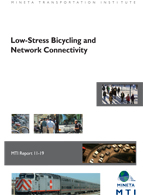- 408-924-7560
- mineta-institute@sjsu.edu
- Donate
Low-Stress Bicycling and Network Connectivity
For a bicycling network to attract the widest possible segment of the population, its most fundamental attribute should be low-stress connectivity, that is, providing routes between people’s origins and destinations that do not require cyclists to use links that exceed their tolerance for traffic stress, and that do not involve an undue level of detour. The objective of this study is to develop measures of low-stress connectivity that can be used to evaluate and guide bicycle network planning. We propose a set of criteria by which road segments can be classified into four levels of traffic stress (LTS). LTS 1 is suitable for children; LTS 2, based on Dutch bikeway design criteria, represents the traffic stress that most adults will tolerate; LTS 3 and 4 represent greater levels of stress.
As a case study, every street in San Jose, California, was classified by LTS. Maps in which only bicycle-friendly links are displayed reveal a city divided into islands within which low-stress bicycling is possible, but separated from one another by barriers that can be crossed only by using high-stress links. Two points in the network are said to be connected at a given level of traffic stress if the subnetwork of links that do not exceed the specified level of stress connects them with a path whose length does not exceed a detour criterion (25% longer than the most direct path).
For the network as a whole, we demonstrate two measures of connectivity that can be applied for a given level of traffic stress. One is “percent trips connected,” defined as the fraction of trips in the regional trip table that can be made without exceeding a specified level of stress and without excessive detour. This study used the home-to-work trip table, though in principle any trip table, including all trips, could be used. The second is “percent nodes connected,” a cruder measure that does not require a regional trip table, but measures the fraction of nodes in the street network (mostly street intersections) that are connected to each other.
Because traffic analysis zones (TAZs) are too coarse a geographic unit for evaluating connectivity by bicycle, we also demonstrate a method of disaggregating the trip table from the TAZ level to census blocks. For any given TAZ, origins in the home-to-work trip table are allocated in proportion to population, while destinations are allocated based on land-use data. In the base case, the fraction of work trips up to six miles long that are connected at LTS 2 is 4.7%, providing a plausible explanation for the city’s low bicycling share. We show that this figure would almost triple if a proposed slate of improvements, totaling 32 miles in length but with strategically placed segments that provide low-stress connectivity across barriers, were implemented.
MAAZA C. MEKURIA, PhD, PE, PTOE
Maaza Mekuria is founder and principal of ADEC (www.axumcorp.com), where he has been doing consulting and research work in engineering since 1998. He is also an adjunct faculty at Evergreen Valley College in San José, California. He has over 25 years’ experience in both public and private sectors. He has a BSCE from Anna University, Chennai, India, and an MSc and PhD from Northeastern University, in Boston, Massachusetts. His research interests include transit modeling, GIS in transportation, traffic/transit simulation, network modeling and analysis, software and database design for transportation applications. He is a registered professional engineer in Massachusetts and a professional traffic operations engineer.
PETER G. FURTH, PhD
Peter Furth is a professor of civil and environmental engineering at Northeastern University (Boston, MA). He is a three-time graduate (BS, MS, and PhD) of the Massachusetts Institute of Technology. For the last 30 years, he has taught, conducted research, and consulted in transportation planning, transit operations and management, traffic engineering, and bikeway planning. He is the author of more than 40 journal articles and of “Bicycling Infrastructure: A Transatlantic Comparison,” a chapter of the forthcoming book City Cycling (John Pucher and Ralph Buehler, eds., MIT Press), and is a contributing author to the NACTO Urban Bikeway Design Guide. In the 1990’s, he spent a year as a visiting scholar at Delft University of Technology, where he was first introduced to low-stress bicycling, and for the last four years has taught a study abroad course in Delft on design for sustainable transportation.
HILARY NIXON, PhD
Dr. Nixon is an associate professor of urban and regional planning at San José State University. Her research and teaching interests in environmental planning and policy focus on the relationship between environmental attitudes and behavior, particularly with respect to waste management and linkages between transportation and the environment. She has a BA from the University of Rochester in environmental management and a PhD in planning, policy, and design from the University of California, Irvine.
-
Contact Us
San José State University One Washington Square, San Jose, CA 95192 Phone: 408-924-7560 Email: mineta-institute@sjsu.edu






